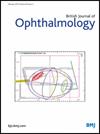Evaluating the risk of recurrence in neovascular age-related macular degeneration using OCT-angiography at the time of treatment exit
IF 3.5
2区 医学
Q1 OPHTHALMOLOGY
引用次数: 0
Abstract
Background/aims To find biomarkers on OCT-angiography (OCT-A) that indicate a higher risk of recurrence in neovascular age-related macular degeneration (nAMD) patients before anti-vascular endothelial growth factor (anti-VEGF) therapy termination. Methods Retrospective, observational study. Stable, inactive nAMD patients who had been treated with a treat-and-extend regimen and met the predefined exit criteria were included. The macular neovascularisation (MNV) lesion was imaged on OCT-A. Lesion area, vessel density (VD), fractal dimension and height of feeder vessel were quantified. Patients with disease recurrence after termination were compared with those who stayed inactive. Results Out of 819 eyes diagnosed with nAMD and 281 with a 2-year follow-up, 77 (27.4%) reached the exit criteria. Thirty-four eyes of 33 (15 female) patients with reliable OCT-A were further analysed. Mean age was 80.35 (±9.29) years, the number of injections was 16.68 (±8.22). Treatment duration before exit was 36.15 (±16.63) months. After exit, 23 eyes stayed inactive for a follow-up period of 23.00 (±16.18) months, and 11 experienced recurrence after 13.36 (±9.90) months. VD was significantly higher in the recurrent versus inactive group with 0.60 (±0.15) versus 0.47 (±0.11), p=0.015. There was an insignificant tendency for the protective properties of type 1 MNV and a low feeder vessel. Conclusion OCT-A is useful in the risk calculation for recurrence in patients who are about to discontinue anti-VEGF treatments in nAMD. Patients with a high VD might need closer follow-ups or continued anti-VEGF treatments even if inactive. Data are available upon reasonable request.在治疗结束时使用oct血管造影评估新生血管性年龄相关性黄斑变性复发的风险
背景/目的寻找oct血管造影(OCT-A)的生物标志物,表明抗血管内皮生长因子(anti-VEGF)治疗终止前,新生血管性年龄相关性黄斑变性(nAMD)患者复发风险较高。方法回顾性观察研究。稳定的、不活跃的nAMD患者已接受治疗和延长方案治疗,并符合预定的退出标准。黄斑新生血管(MNV)病变在OCT-A上成像。对病变面积、血管密度(VD)、分形维数和供血血管高度进行量化。将终止治疗后疾病复发的患者与不运动的患者进行比较。结果经2年随访,诊断为nAMD的819只眼和281只眼中,77只(27.4%)达到退出标准。对33例(15例女性)34眼可靠OCT-A进行进一步分析。平均年龄80.35(±9.29)岁,注射次数16.68(±8.22)次。出院前治疗时间36.15(±16.63)个月。术后23只眼随访23.00(±16.18)个月,11只眼随访13.36(±9.90)个月复发。复发组VD明显高于无活动组,分别为0.60(±0.15)和0.47(±0.11),p=0.015。1型MNV和低给料血管的保护性能没有明显的趋势。结论OCT-A可用于计算nAMD中即将停止抗vegf治疗的患者复发风险。高VD患者可能需要更密切的随访或继续抗vegf治疗,即使不活动。如有合理要求,可提供资料。
本文章由计算机程序翻译,如有差异,请以英文原文为准。
求助全文
约1分钟内获得全文
求助全文
来源期刊
CiteScore
10.30
自引率
2.40%
发文量
213
审稿时长
3-6 weeks
期刊介绍:
The British Journal of Ophthalmology (BJO) is an international peer-reviewed journal for ophthalmologists and visual science specialists. BJO publishes clinical investigations, clinical observations, and clinically relevant laboratory investigations related to ophthalmology. It also provides major reviews and also publishes manuscripts covering regional issues in a global context.

 求助内容:
求助内容: 应助结果提醒方式:
应助结果提醒方式:


